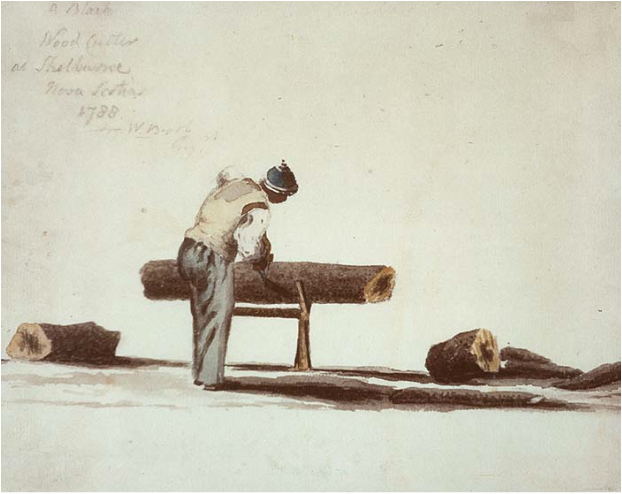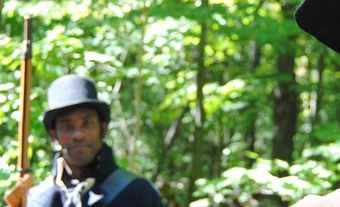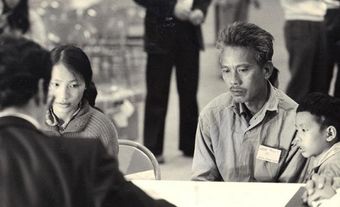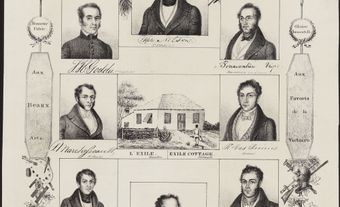On 26 July 1784, a mob of Loyalist settlers stormed the home of a Black preacher in Shelburne, Nova Scotia. They were armed with hooks and chains seized from ships in the harbour. The confrontation ignited a wave of violence in Shelburne County that lasted approximately 10 days. The majority of the attacks targeted the county’s free Black population. The Shelburne Riot has been described as the first race riot in North America. (See also British North America.)
Settlement History
Shelburne County sprung up virtually overnight with the arrival of Loyalist refugees in the spring of 1783. Among the first arrivals in the area were many Black Loyalists. During the American Revolution, as many as 10,000 previously enslaved Black people — approximately one-fifth of the total Black American population in 1783 — fought alongside the British in exchange for their freedom. At the close of the war, many relocated to Nova Scotia. By the end of the year, almost 1,500 had moved to Shelburne County. The majority of these settled in Birchtown, a community west of Shelburne. At the time, it was the largest community of free Black people anywhere in North America. (See also Black Enslavement in Canada.)

Racial Tensions
Black Loyalists soon discovered that freedom was a far cry from equality. Land grants promised by British authorities were always delayed, smaller and in worse locations than those received by white Loyalists. With few possessions and no land, many Black settlers were forced into indentured servitude. They frequently worked in conditions that were startlingly similar to the slavery from which they had escaped. In the worst cases, free Black Loyalists were kidnapped and re-enslaved in the United States or the Caribbean. (See also Black Enslavement in Canada.)
Though it never developed the plantation economy of the American South, Nova Scotia was undoubtedly a society with enslaved people. In the wake of the American Revolution, Loyalists brought at least 15,000 enslaved people to various corners of the British Empire. Approximately 2,000 were brought to British North America. A minimum of 1,200 were brought to the Maritimes alone. For most white settlers, skin colour and servitude were deeply linked. Enslavers in Nova Scotia most likely felt threatened by the presence of the free Black Loyalists. Birchtown became a place of refuge for previously enslaved people in the colony. Free Black Canadians would mingle with Black enslaved people. It was becoming difficult to maintain the fiction that racial exploitation was simply “natural.” (See Racism.)
In Shelburne County, white dissatisfaction towards British administrators was often directed towards neighbouring Black communities. Arriving with little money, white refugees often faced significant delays in receiving their promised land allotments. As such, many were forced to work as labourers in order to earn a living. Those who did resented the fact that free Black workers were willing to work for far less than white labourers deemed acceptable.
Shelburne Race Riot
It didn’t take long for racial animosity to arise. Tensions reached a breaking point in Shelburne on 26 July 1784. A group of about 40 white Loyalists demolished the home of Baptist preacher David George. George had chosen to establish his church (see Christianity) in Shelburne rather than Birchtown. Moreover, he had challenged the established racial hierarchy by baptizing white Loyalists. (See also Racial Segregation of Black People in Canada.) The mob also tore down the houses of about 20 other free Black people living on George’s property.
Despite threats, George continued to preach from his church in Shelburne. The mob returned, beating the pastor with sticks and chasing him into a swamp. The riot spread. Disgruntled white settlers seized the opportunity to lash out. There are few firsthand accounts of the ensuing days, but a merchant in nearby Liverpool recorded hearing that “Some thousands of people assembled with clubs and drove the Negroes out of town.”
While Black Loyalists were the primary targets, rioters also attacked white settlers that were believed to be colluding with the incompetent British authorities. Surveyor Benjamin Marston fled to the army barracks, where his remaining friends convinced him to slip away on a boat to Halifax.
Shelburne County’s Black Loyalists had no such refuge. Rioting continued for at least 10 days. Incursions into Birchtown were reported for up to one month. Four companies of the 17th Regiment were dispatched to maintain order in the weeks following the riot. Governor John Parr also personally visited Shelburne on 23 August.
Marston, despised by Shelburne’s white Loyalists, provided a convenient scapegoat for the situation. He was and was fired. Evidently concerned that violence might re-emerge, Parr also dispatched a naval frigate to support the 17th Regiment. Only one individual was charged in connection with the riot.
Legacy
The Shelburne Riot was emblematic of the broader racial prejudices encountered by Black Nova Scotians in the years after the American Revolution. It had little immediate effect on the county. However, within several years, the region soon faced a faltering economy and declining population. Many Black Loyalists eventually relocated to other parts of the province. In 1791, Birchtown residents were given the option of sailing to a new colony in Sierra Leone. At least half of the town’s families agreed to leave the following year. They preferred an uncertain future on a new continent to the conditions in Shelburne County.

 Share on Facebook
Share on Facebook Share on X
Share on X Share by Email
Share by Email Share on Google Classroom
Share on Google Classroom



